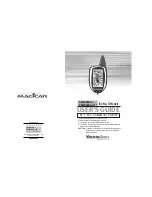
HPM6 Power Management Controller User Manual
Page 53 of
146
Suppose SG rated power is 1000kW, DG rated power is 500kW, the fixed min on-load percentage is
10%, the fixed max on-load percentage is 90% and the fixed output power percentage is 80%. According
to the change of the total load, SG and SG on-load are as shown in the 5 parts of figure above:
The first part: (0-150)kW, SG and DG share the power;
The second part: (150-850)kW, DG on-load is 50kW(10%), the rest is loaded with SG;
The third part: (850-1200)kW, SG on-load is 800kW(80%), the rest is loaded with DG;
The fourth part: (1200-1300)kW, DG on-load is 400kW(80%), the rest is loaded with SG;
The fifth part: (1300-1500)kW, SG on-load is 900kW(90%)+sharing excess power (total
load-1300kW), DG on-load is 400kW(90%)+sharing excess power (total power-1300kW).
NOTE:
If the fixed min on-load percentage is set to 0, DG will start with load only when SG on-load exceeds the fixed
power percentage.
11.3
SYNCHRONIZATION
HPM6 controller enables dynamic and static synchronizations. It is defaulted to adopt dynamic
synchronization because of its fast speed to close breakers. It is with 0.1Hz slip frequency,
synchronization can be finished in 10s and ramp on load immediately once generator closed.
During dynamic synchronization, the unit which is going to be synchronized is running at a different
speed to generator on the bus, and the speed difference between them is named as slip frequency.
Generally, the synchronizing unit is running at a positive slip frequency which means it is relatively
faster than bus generator, so that the generator reverse power is avoided after synchronizing.
The aim of synchronization is reducing the phase angle between two systems (refer to 3-phase
systems of generator and bus).
Voltage difference, frequency difference and angle difference should be set during dynamic
synchronization. The breaker is going to be closed if all of them meet the requirement between
generator and bus.
Static synchronization means that genset ready to synchronize runs in same or extremely similar
speed with bus genset, adjusts phase synchronization by phase synchronizer, and sends breaker close
signal. It is not recommended to use relay control in static synchronization because it can’t precisely
adjust due to its slow response. In static synchronization, breaker response time has no higher
requirements because of very small or non-existent frequency difference.
11.4
HEAVY CONSUMER INQUIRY
Each HPM6 controller can handle up to four Heavy Consumers (HC).
Response priority for the same controller is HC1>HC2>HC3>HC4 if HC ID and priority are both set
as 128; while for the different controllers, controller’s ID determines HC response priority, which means
first response to HC request from controller with small ID number.
If HC ID and priority are not 128, HC response depends on ID and priority, which means first
response with small priority, first response with small ID number if the priority is same.
If HC ID number is same and not equal to 128, this heavy consumer has redundancy, which means
HC signal can be connected to multiple ports. It is active when one HC request feedback is active.
When HC power meets the requirement, it outputs HC permission and response signals.
When a heavy consumer is requested to the power station, system will reserve the required power
on the bus, until sufficient predicted available power is present at the bus.















































